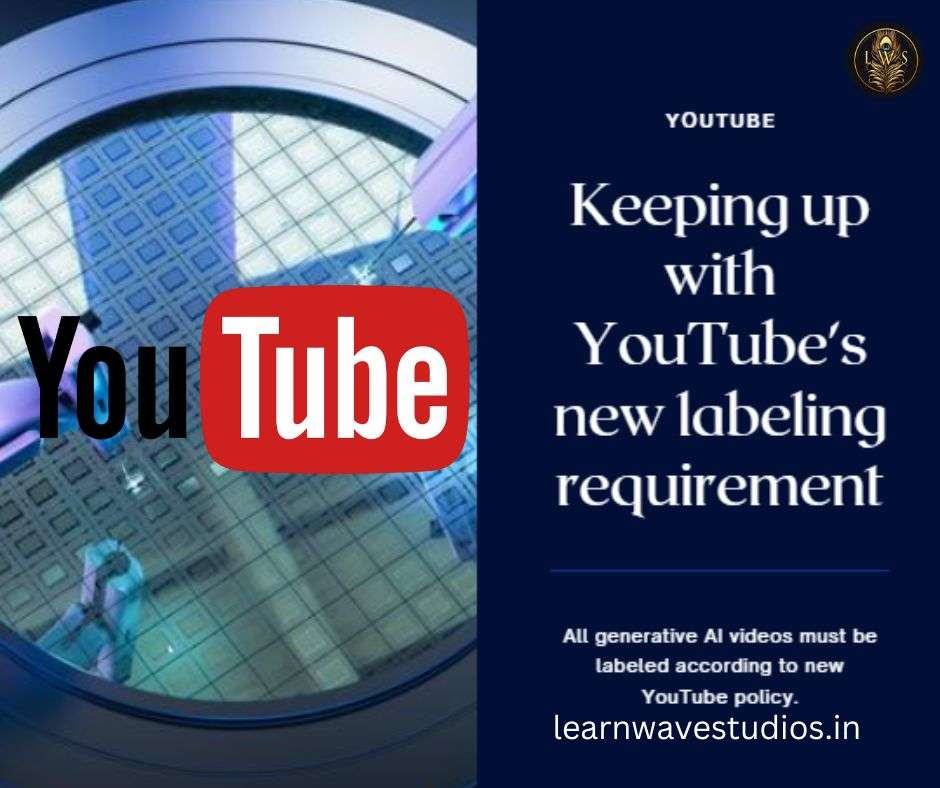YouTube recently announced a new Labeling requirement for creators to label videos made with generative AI, a move aimed at enhancing transparency and trust on the platform. This change marks a pivotal moment in the evolving landscape of online content creation, as the prevalence of AI-generated media continues to rise .

Why Labeling Matters
Transparency in content creation is crucial, especially in the context of AI-generated media. With the rapid advancement of AI technology, it has become increasingly challenging to discern between genuine and AI-generated content. This poses serious implications for the authenticity and accuracy of information available online.
What Requires Labeling?
Creators will now be obliged to apply the new label to videos that feature the following elements :
- Realistic manipulation of a person’s likeness, such as deepfakes
- Creation of a voice based on a real person’s voice
- Realistic alteration of a physical location, like setting a building on fire
- Creation of a realistic scene that could deceive viewers into believing it is real, such as a simulated tornado approaching a town
When the Label May Not Be Necessary
It’s important to note that not all AI-generated content will require labeling. YouTube exempts obviously altered or synthetic media, including animations, videos with special effects, certain face filters, and other non-realistic visual and audio elements from this labeling requirement.
Enforcement and Implications
Although creators are “required” to add the label when their content meets the specifications, how this will be enforced remains a matter of uncertainty. While YouTube has mentioned a possibility of applying the label themselves if creators fail to do so, as of now, the system is largely based on an honor code.
The Role of Creators
This change not only places responsibility on YouTube and its creators but also emphasizes the importance of ethical content creation. While the new labeling requirement represents a step forward in addressing the challenges posed by AI-generated content, it remains crucial for creators to uphold transparency and integrity in their work .
In an era where technological advancements continue to reshape the digital landscape, the need for transparency and accountability in content creation has never been more critical. YouTube’s new labeling requirement for generative AI videos seeks to address these challenges, although implications and long-term effects remain to be seen.
By embracing these changes and adapting to evolving standards, creators can contribute to a more transparent and trustworthy online environment
YouTube’s New Labeling Requirement for Generative AI Videos
YouTube recently announced a new requirement for creators to label videos made with generative AI, a move aimed at enhancing transparency and trust on the platform. This change marks a pivotal moment in the evolving landscape of online content creation, as the prevalence of AI-generated media continues to rise .
Why Labeling Matters
Transparency in content creation is crucial, especially in the context of AI-generated media. With the rapid advancement of AI technology, it has become increasingly challenging to discern between genuine and AI-generated content. This poses serious implications for the authenticity and accuracy of information available online.
What Requires Labeling?
Creators will now be obliged to apply the new label to videos that feature the following elements :
- Realistic manipulation of a person’s likeness, such as deepfakes
- Creation of a voice based on a real person’s voice
- Realistic alteration of a physical location, like setting a building on fire
- Creation of a realistic scene that could deceive viewers into believing it is real, such as a simulated tornado approaching a town
When the Label May Not Be Necessary
It’s important to note that not all AI-generated content will require labeling. YouTube exempts obviously altered or synthetic media, including animations, videos with special effects, certain face filters, and other non-realistic visual and audio elements from this labeling requirement.
Enforcement and Implications
Although creators are “required” to add the label when their content meets the specifications, how this will be enforced remains a matter of uncertainty. While YouTube has mentioned a possibility of applying the label themselves if creators fail to do so, as of now, the system is largely based on an honor code.
The Role of Creators
This change not only places responsibility on YouTube and its creators but also emphasizes the importance of ethical content creation. While the new labeling requirement represents a step forward in addressing the challenges posed by AI-generated content, it remains crucial for creators to uphold transparency and integrity in their work .
In an era where technological advancements continue to reshape the digital landscape, the need for transparency and accountability in content creation has never been more critical. YouTube’s new labeling requirement for generative AI videos seeks to address these challenges, although implications and long-term effects remain to be seen.
By embracing these changes and adapting to evolving standards, creators can contribute to a more transparent and trustworthy online environment

